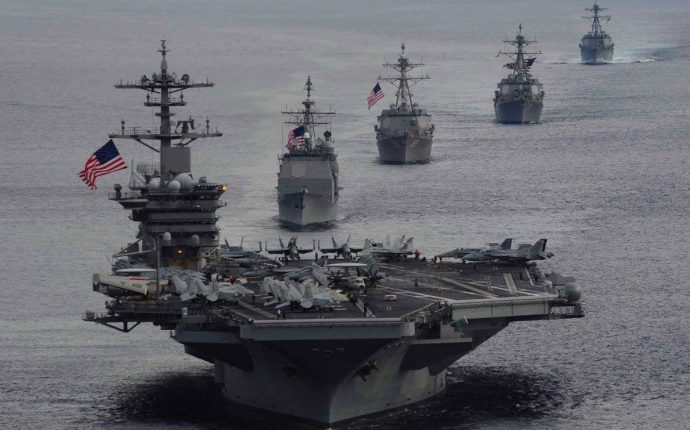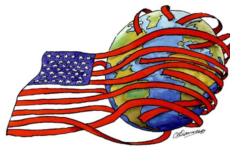Naval Power and World Politics
Since the advent of the mercantile era in the 17th century, great powers relied heavily on the oceans and the seas for the pursuit of international trade. Things have not changed much, and, as Margaret Blunden argues, “with the world’s maritime transport system at the forefront of globalization” (Blunden 2012), it is hardly plausible to expect any inflexion of that trajectory in the decades to come. This implies for governments and for policy-makers to fully grasp the importance of the maritime dimension in the conduct of contemporary global politics.
The significance of seas and oceans induced states to develop military capabilities able to operate in water. Even if naval warfare has a long history dating back to the Roman Empire, it makes sense to date the beginning of the machine age in naval warfare in 1838, with the emergence of the use of steam engine (Lautenschläger 1983). Things have gradually evolved and contemporary navies are relying on state of the art technologies to realize the varied tasks they are assigned to. This short written piece will explore the role of the naval power in our modern era, with a special focus on its international role.
In this essay, I take the standpoint of Sir Julian Corbett to try to demonstrate that “sea power [is] no more than a means to political end” (Baylis & Gray 2015). In this sense, I will try to answer the following question: to which extent is naval power a crucial component of a state’s foreign policy? To cover the main dimensions implied by this broad interrogation, I will first discuss the use of naval power as a predominant diplomatic tool to apply political pressure by using the recent example of the military disputes in the South China Sea as well as the Yeonpyeong incident of 2010 in the Yellow Sea. Secondly, I will show how multilateral counterpiracy operations off the coast of Somalia underline the usefulness of navies as tools of preservation of the international maritime trade regime.
I personally argue that naval power is a core component of modern world politics, especially because of its relevance regarding operations during peacetime and its multidimensional usability.
To begin with, it is important to clarify the dense theoretical framework and semantic issues surrounding the diplomatic use of naval power. Naval diplomacy is to be understood as following: “the aim is political influence and the target is the minds and perceptions of policy-makers in hostile and friendly powers” (Widen 2011). While influencing ones perception might rely on a wide spectrum of tools, I argue here that Hedley Bull’s visibility (Widen 2011) factor is particularly relevant for the following two issues.
Firstly, as tensions are rising in the South China Sea, mainly because of China’s refusal to agree with The Hague Permanent Court of Arbitration verdict rendered on the 12th July 2016 accusing it of illegitimate territorial claims (Wyne 2016), Beijing has decided to conduct a joint naval exercise with Russia in the region a few weeks later, in September (Buckley 2016). How to interpret that move coherently? I argue that this behaviour is to be interpreted as what Robert Mandel calls a “show of force”. This might be done to exercise “political pressure” (Widen 2011) on the countries engaged in the dispute, in this case Philippines, the United States, Japan or Vietnam, to persuade them, or to send a symbolic signal to the belligerents and the international community by affirming a claimed and indisputable sovereignty over a given territory.
Secondly, concerning the Yellow Sea conflict, deeply discussed and analysed by Jerker Widén, it is fascinating to look at the US response and the way they implicitly sent incentives to both parties – North Korea and South Korea – to influence their perceptions. The fact that they used the USS George Washington for such a mission is revealing of one of the doctrinal roles historically assigned to aircraft carriers, i.e. their efficiency to act as a “Geopolitical Chess Piece” (Rubel 2011). This symbolical task is consubstantially linked to the visibility factor mentioned previously, in the sense that the ship is expected, in this phase, to convey a symbolic power due to its presence rather than a real firepower because of its effective viability (Widen 2011). Nevertheless, this argument must be counterbalanced in this case, as an aircraft carrier does effectively have huge multidimensional combat capabilities, even if its use is purposely symbolic.
These first two examples allowed me to show the way naval power might be used as a diplomatic vector of influence. In fact, it relies on subjective perceptions and on subtle stimulus expected to have a psychological impact on its adversaries and allies.
Furthermore, I argue that naval warfare is also a mere way of ensuring the on-going march of international trade, especially regarding its ability to deter piracy on the main maritime routes. Our global economy being embedded in the principles of capitalism and liberalism, providing the security and control of these routes allows the states to reduce the margin of uncertainty regarding the free movement of goods in international waters. A significant illustration of the fight against piracy is the desire, in 2008, to set an international coalition supposed to act jointly against this plague mainly happening off the coast of Somalia (Leymarie 2008). Even if maritime security lies outside the realms of naval diplomacy (Widen 2011), I argue that, in the case of counterpiracy, naval power is extremely important to ensure the perpetuation of the economic activity, which is one of the strongest levers of influence in international politics. The significance of maritime trade is also underlined with the growing concern about piracy in the Gulf of Guinea. In this case, international inference will be undermined by the fact that the pirates operate into territorial waters, notably the Nigerian one (De Luce 2016), rendering a joint intervention in the frame of a global institution such as the UN or the NATO nearly impossible.
I believe that these two cases help to demonstrate how relevant is naval power when ensuring the security of international trade routes, where safety must be ensured in order to provide reassuring structural conditions for merchants vessels.
To conclude, I exposed the relevance of naval power as a crucial component of a state’s foreign policy. My first axis helped to show that naval power was, depending on the situation, an important diplomatic tool. The way it is being used in contemporary conflicts I used as examples is mostly symbolic and relies heavily on the transmission of subtle messages. My second axis was focused on the foreign trade and economic policy of the states and demonstrated that naval power was cardinal in ensuring international maritime routes from threats such as piracy.
I argue that, regarding these elements, it is relevant to say that naval power plays a great role in the conduct of international politics. Its influence still must not be overestimated, as 1) “naval forces can only act as part of a larger diplomatic effort and never act on their own” (Widen 2011) and thus being a “Mahanian” thalassocracy (Zajec 2016) alone is not sufficient to have a hegemonic position in the international system, and 2) naval power might exert an influence on some core factors of world politics such as economy and trade, but is not per se the main factor entailing the conduct of world politics. It remains one of the numerous ways to partly influence this complex web of interrelated phenomena.
Finally, I argue that it is important to keep in mind that the way naval power influences the contemporary global politics might be scrutinized through other lenses, such as the way navies operate to deny access to some strategically important zones, or effectively use military power in asymmetrical conflicts. This brief essay does not have the pretention to answer the problématique in its totality, but to cover some of its aspects that I found particularly relevant regarding the 21st century context.
Bibliography
- Baylis, J., & Gray, C. S. (2015). Strategy in the contemporary world: an introduction to strategic studies. Oxford University Press
- Blunden, M. (2012). « Geopolitics and the northern sea route ». International Affairs, 88(1), 115-129.
- Buckley, C. « Russia to Join China in Naval Exercise in Disputed South China Sea.” The New York Times, 29.07.2016.
- De Luce D. « Why Is it so Hard to Stop West Africa’s Vicious Pirates? » Foreign Policy, 23.09.2016
- Lautenschläger, K. (1983). « Technology and the evolution of naval warfare ». International Security, 8(2), 3-51.
- Leymarie P. » Flottes occidentales contre pirates somaliens” Le Monde Diplomatique, Novembre 2008
- Rubel, R. C. (2011). « The future of aircraft carriers ». Naval War College Review, 64(4), 13-27.
- Widen, J. J. (2011). « Naval Diplomacy—A Theoretical Approach ». Diplomacy & Statecraft, 22(4), 715-733.
- Wyne, A. « U.S. Hypocrisy in the South China Sea.” Foreign Affairs. 14.06.2016
- Zajec, O. (2016) Introduction à l’analyse géopolitique, Editions du Rocher.
This essay was written as part of an evaluation for the course Strategic Studies taking place at Sciences Po.









